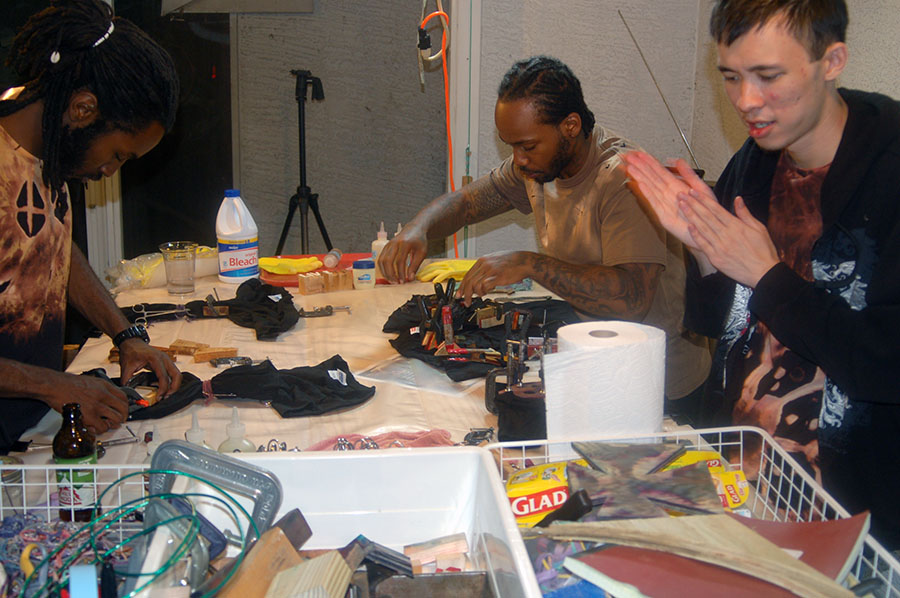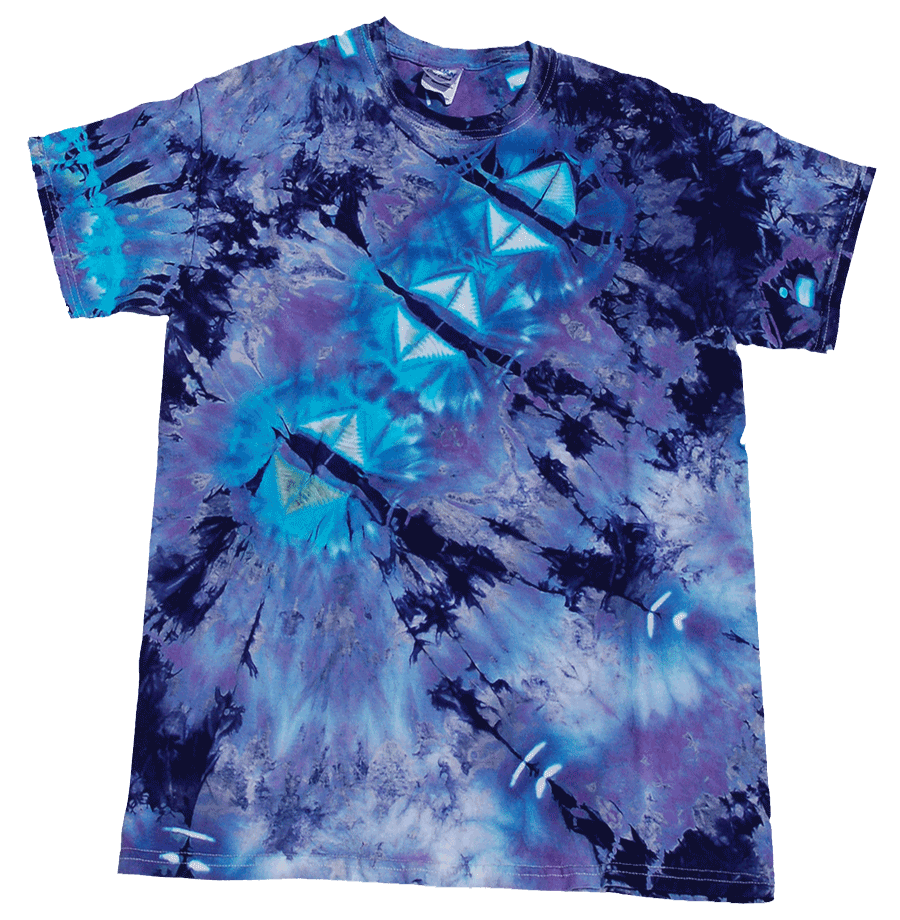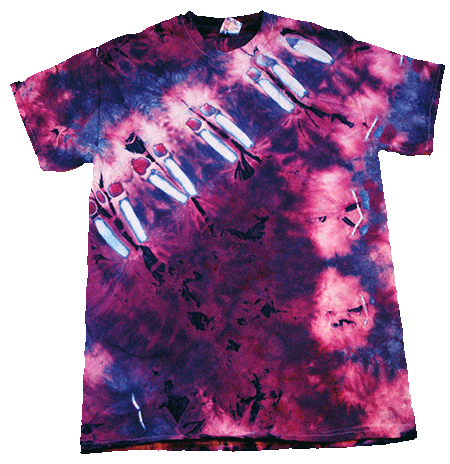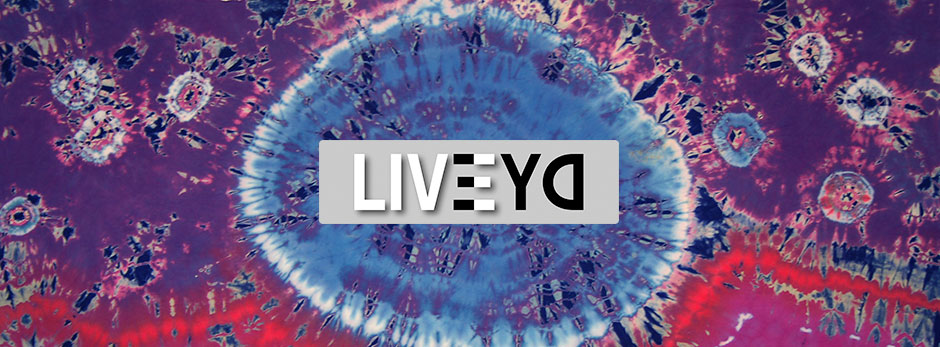
New dyers (but old souls) Judah (left) and Justin work with Craig at a Funshop (see bigger versions of these side images on your computer screen by narrowing the width of your browser window)
Live Dye – Introduction to Techniques
How to do Dye Resist & Discharge Resist (Tie-Dye)
Welcome to the Live Dye Techniques pages! Unfortunately, most of the material I've seen on tie-dyeing is very basic and unimaginative. More importantly, it really doesn't lead you to professional or fine-art results. There are a number of fine reference books on tie-dyeing, and some informative web sites, but I thought that I'd boil down the information into a fine, thick, inclusive, and tasty series of pages. In America, tie-dye has lost much of whatever fine art association it once had, though there are a few out there doing wonderful work (I really like ThaiDye). If you appreciate my work, I'd like to help you do fine art-quality work. But before we get into how to do it, let's examine the history of the technique briefly:
A Very Brief History of Tie-Dye
Dye Resist is Ancient
The perishable nature of fabric precludes us from establishing when tie-dye and other resist techniques such as batik were first practiced, but it is clearly an ancient art practiced by all early civilizations. It's simplicity and attractiveness undoubtedly led to it's independent discovery many times throughout history. Most of these techniques are still in practice, largely unchanged, to the present day, including the Japanese art of shibori, Indian bandani (bandhni, bandhej), Malay-Indonesian plangi, and various African techniques, the indigo dyeing being a particular favorite.
These techniques are almost entirely tie dyeing, as they use fine string, thread, or the like to bind fabric to resist the entry of dye into the cloth. This binding is typically in the form of regular repeats, often in mind-numbingly large numbers and finger-grindly close spacing, small size, and fineness. This is illustrated nicely on the Wikipedia Bandhani web page, particularly the purple print. Sometimes seeds, stones, or other small items are placed behind the fabric, pinched from the other side, and thread is wrapped around the fabric just behind the object. In tritik, the fabric is sewn with broad stiches and the tread drawn tight to form tightly packed pleats, typically leaving behind needle holes in the fabric and a pleasing linear resist that can be used to render shapes. An interesting Oaxacan cultural site has some good examples of tritik and shibori in process.
Using resists to create designs on fabric is almost certainly as old as fabric itself. The sun is a potent discharge (bleaching) agent, and shortly after fabric was first made (or even before when hides were used for clothing), an early resister noticed that a piece of it left in the sun bleached where exposed. The patterns that resulted may have pleased (or appalled) her, but the concept is as simple as this. Prevent dyeing or discharge, and create design.
While many of the traditional techniques that are still practiced probably originated in India and passed to other regions of the Far East, dye and discharge resist were clearly discovered by all ancient civilizations, and most maintain a tradition of the practice. If you take up the practice, know that you're carrying on a tradition that has existed since Man needed clothing – or at least clothing that he could show off to impress. As you'll see in the following pages, we've found that it's not only a great art form, but is also one of the most accessible doorways leading to more fun. And we believe that fun is what makes life worth living. Read on, join in, and have fun!
Some Tasty Web Links for Dye and Discharge Resist
Please let us know if any of these go defunct, and about any sites you'd recommend.
- Dr. Paula Burch's big and informative hand-dyeing pages
- Julie Jennings' tie-dye history page
- The Indian Art & Craft blog's brief history of Bandhani
- Asanjo Kutch's history of Bandhani by the Kutchi people of Western India
- Cultural China's brief article on tie-dye by the Bai
- The World Shibori Network's beautiful web site
- The Batik Guild's beautiful web site
- ThaiDye.com's exciting commercial site offering mudmee dyes
- My own pages on household bleach and thiourea dioxide discharge


A Few Good Books on Dye and Discharge Resist
Some date from the heyday of American tie-dye (the 1970's) but are either still in print or readily available used.
- Dona Z. Meilach's excellent Contemporary Batik and Tie-Dye (1973)
- Nancy Belfer's Batik and Tie-Dye Techniques (1977)
- Wada, Rice, and Barton's wonderful Shibori: The Inventive Art of Japanese Shaped Resist Dyeing (1983)
- Janice Gunner's recent introduction to shibori: Shibori for Textile Artists (2007)
- Mandy Southan's beautiful introductory how-to: Shibori: Designs & Techniques (2009)
- Lisa Kerpoe's book focused on liquid resists: Visual Texture on Fabric (2012)
- Ann Johnson's similar book on painting and printing with dye: Color By Design (2001), and her Color By Accident (1997) on immersion dyeing
